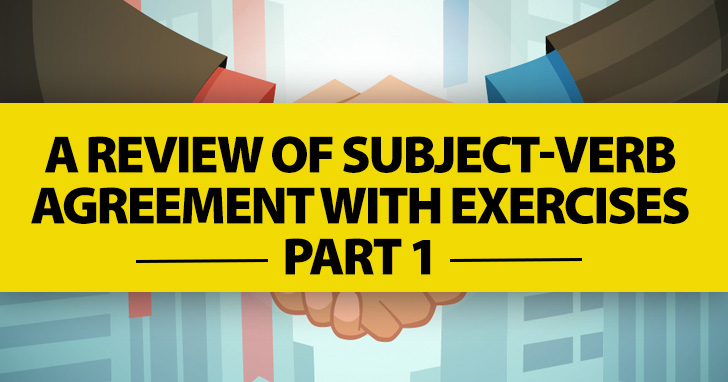A new class of novice language learners enters the classroom to begin their journey to fluency in English.
With a whole new world and its lexicon in front of them, where does a teacher and an ESL student start? As you know, one of the earliest topics covered in ESL classes is subject-verb agreement. Without that, even the most simple sentences will not be grammatical. But achieving correct subject-verb agreement may be more complicated that your students realize. Here are some tips to make sure your students’ subjects and verbs are getting along and exercises to practice getting it right.

Get Your Subject- Verb Agreement Right for Your Class
-
1
Basic Subject-Verb Agreement
In essence, subject-verb agreement is simple: singular subjects take singular verbs and plural subjects take plural verbs. Other languages may have different verb endings for singular and plural, masculine and feminine, first second and third person subjects. Regular English subjects and verbs fall into only two categories. Singular first person, second person, and plural nouns (I, you, we, you, they, the women, my brothers) take the base form of regular verbs. (I see, you see, they see, etc.) Singular third person nouns and pronouns (he, she, it, Tom, the woman) add an –s to regular verbs for proper agreement. (He sees. Tom sees. The woman sees.) In essence, that is subject-verb agreement. The nouns may be common nouns or proper nouns, but either way they will follow this pattern of verb agreement.
Practice: To give your students experience with simple subject-verb agreement, give them a list of several nouns and pronouns in English as well as a list of several regular verbs. Have students use the subjects and verbs to write grammatical sentences, paying attention to the verb endings for first person singular nouns.
-
2
Irregular Plural Nouns
While most nouns in English end in –s when they are plural, not every noun follows this pattern. Some irregular nouns take irregular plural forms, and these irregular plurals can cause confusion for your students. Nouns that might especially cause confusion for your students are those that take the same form for both singular and plural nouns. Such examples include deer, fish, sheep, moose, series, species, and wheat. In these cases, students will have to determine the context of the noun before deciding whether it is singular or plural and therefore which verb ending to use.
Practice: Let your students roll their fate with this fun review of subject-verb agreement with irregular plural nouns. On one blank die, write six different irregular plural nouns. On another blank die, write the numbers 1, 1, 1, 2, 3, 4. Students take turns rolling the dice to determine the subject of their sentence. If they roll a one they must form a sentence using the irregular noun in its singular form. If they roll a two, three, or four, they must form a sentence using the irregular noun in its plural form.
-
3
Indefinite Pronouns
Indefinite pronouns are those that do not refer to any one specific person or thing. Some are singular while others are plural. The most common singular indefinite pronouns in English are anyone, no one, everyone, everybody, someone, and nobody. Though they can refer to any person in existence and, in the case of everyone and everybody, all people in existence, these pronouns are always singular and as a result take a singular verb.
- No one takes English III before taking English I.
- Someone likes to text in class.
Make sure your students are clear that these subjects are singular, particularly in the case of everybody and everyone. Though they refer to a group of people (much like collective nouns, which we will discuss below) they are singular and must take a singular verb.
- Everybody is here.
- Everyone eats lunch at noon in our school.
- Each of the movies starts at a different time.
- Each of the students has finished his test.
The indefinite pronouns all and some, on the other hand, are plural. They therefore take plural verbs.
- All students take English III before taking English I.
- Some students like to text in class.
None is an indefinite pronoun that is an exception to the rule: it can be either plural or singular depending on what it refers to in its context.
- None of them text in class.
- None of them texts in class.
Practice: An easy way to practice agreement with indefinite pronouns is with a fill in the blank exercise. Give students several sentences in which the indefinite pronoun is replaced with a blank and give them a list of the indefinite pronouns from which to choose to complete the sentences. Students can choose what they think is the best pronoun to complete the sentence provided it agrees with the verb.
We aren’t done discussing subject-verb agreement quite yet.
Check out part two of Why Can’t We All Just Get Along? A Review of Subject-Verb Agreement with Exercises to find out more potential confusion your students might have with subject-verb agreement and how to walk them through it.
P.S. If you enjoyed this article, please help spread it by clicking one of those sharing buttons below. And if you are interested in more, you should follow our Facebook page where we share more about creative, non-boring ways to teach English.







